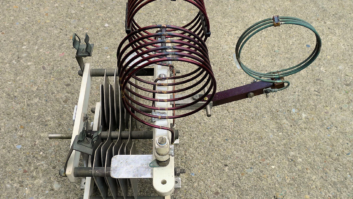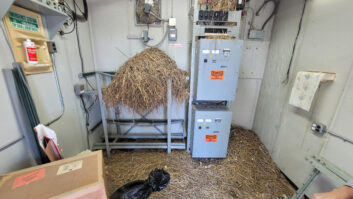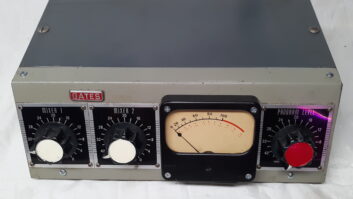
Fig. 1: Proper transmitter grounding. Make sure the ground strap is connected to ground.
In conversations with several contract engineers, I’ve been amazed at the number of transmitter sites they find with no transmitter ground strap connected.
Depending on the power line ground is risky. Fig. 1 shows a good example of proper grounding, as found at the Entercom Scranton cluster stations.
One contract engineer recalls a site where he found ground strap stuffed in a hole in the floor — connected to nothing!
Every couple of columns, we have focused on things that engineers “will get around to doing” but somehow never do. Remember the transfer switch interlocks that weren’t connected? Fig. 2 shows both control and interlock wiring connected, as it should be.
With respect to grounding issues, don’t assume a thing. Tug on that ground strap next visit to the transmitter site and make sure it’s properly connected.
Thanks to Dan Pregnar and his crew at Entercom Scranton/Wilkes-Barre for the pictures of how to do things right.
* * *
You’ll recall Bruce Blanchard’s osprey invasion in our column of Nov. 18.
Well, readers, you’ve come through again. Here are some great suggestions for keeping birds away from the STL dipole.
Tony Wortmann of Radio.comm does contract work for seven stations and manages a business band sales and service operation. He offers a cheap fix that has worked for him: Place a bright spot light below where the birds perch and shine it upwards. If you don’t have power on the tower, just run a power cord connected to a 500-watt halogen light mounted below their nest.
They’ll find a better place to nest and leave the STL alone.
* * *
Cox Radio Tampa’s Roz Clark offers a tactic used by some Florida seaside restaurants to keep birds out of outdoor dining areas.
This solution too is inexpensive; it involves heavy gauge nylon fishing line. Roz’s suggestion is to run several lengths of the line from the feed (perch) out to the rim of the dish, in several radial directions.

Fig. 2: Buy a pre-wired RF switch connection cable to ensure that control and interlocks are connected properly. The monofilament will have negligible wind load effects and won’t cause an issue with winter icing or the RF feed itself. The birds will not light on the feed horn protected this way.
Roz writes that he has not tried this approach, but may because he encounters seasonal groups of snowbird vultures that load up his STL tower every spring and fall. Although birds have not caused any degradation of the STL feed, their droppings have degraded the roof of the STL shack. You don’t want to look up when the birds are roosting.
* * *
William MacDonald is CE for KMIK(AM) in Phoenix. His solution to the birds on the STL feed horn is to provide them with a better place to perch. Installation of an ice shield above the STL dish will protect the feed horn from falling ice and offer the birds a flat surface for eating their fish.
* * *
If all else fails, resort to modified spike strips!
Wayne Eckert is the assignment manager for Channel 1 Images. Wayne suggests having a local plastic shop cut a strip of 1/4-inch Plexiglas or Lexan in a sawtooth pattern. The length of the strip should be shorter than the length of the feed, with the narrow sawtooth spikes cut higher than the length of the offending bird’s legs.
This “spike strip” can be mounted to the feed with black nylon wire ties, with the spikes facing up of course.
In theory this should make it difficult for the birds to land and uncomfortable for them to sit if they do. Additionally, a bright colored plastic as a visual warning can deter landing.
So we’ve loaded Bruce up with a good number of solutions. We’ll let you know what he tries, and how successful the remedies are this spring.
John Bisset marked his 40th year in broadcasting in October. He is international sales manager for Europe and Southern Africa for Nautel and a past recipient of SBE’s Educator of the Year Award. Reach him at[email protected]. Faxed submissions can be sent to (603) 472-4944.
Submissions for this column are encouraged and qualify for SBE recertification credit.












